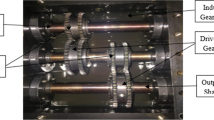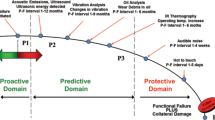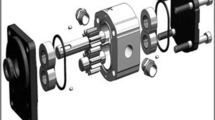Abstract
Wear particles are generated in the mechanical system due to different modes, such as abrasion, adhesion, erosion, oxidation, corrosion, and severe sliding. Wear particle analysis is a non-intrusive tool to monitor the condition of lubricated components. The study of wear particles gives information related to the size of particle, concentration and quantity, material composition and size distribution, from which operating wear mode can be predicted to observe the state of a component. This paper has discussed the case study for wear particle classification using different parameters. Experimentation has been carried out to observe the nature of wear and wear particle classification by operating gearbox for 500hrs. Lubrication is essential for correct functioning of gearbox therefore, ferrographic analysis is carried to measure the concentration of wear particle through lubricating oil. Olympus Stream Basic Software is used to analyze ferrogram slides to measure different parameters area, perimeter, aspect ratio, shape factor, mean radius, and mean color intensity values of wear particles. Area and perimeter of normal rubbing wear is used to classify them into small-, medium-, and large-sized particles.








Similar content being viewed by others
Change history
08 September 2023
A Correction to this paper has been published: https://doi.org/10.1007/s11668-023-01757-x
References
W.W. Seifert, V.C. Westcott, A Method for the Study of Wear Particles in Lubricating oil. Wear. 21, 27–42 (1972). https://doi.org/10.1016/0043-1648(72)90247-5
D. Scott, V.C. Westscott, Predictive Maintenance by Ferrography. Wear. 44, 173–182 (1977)
D. Scott, Debris Examination- A Prognostic Approach to Failure Prevention. Wear. 34, 15–22 (1975). https://doi.org/10.1016/0043-1648(75)90304
D. Scott, W.W. Seifert, V.C. Westcott, Ferrography- An Advanced Design and for the ’80s. Wear. 34, 251–260 (1975). https://doi.org/10.1016/0043-1648(75)90094-0
Donald F. Kautzman, DR-5 Direct Reading Ferrography User Manual, Predict Technology.
Tonggang Liu, Xiaohang Tang, Zhiyi Yang, The Theory of Debris Group in Ferrographic Analysis, Proceedings of CIST, 2008, p 361-365, https://doi.org/10.1007/978-3-642-03653-8 112.
P.P. More, M.D. Jaybhaye, Prognostic Approach for Ferrographic Analysis of Gear Box, IOSR Journal of Engineering (IOSR JEN), 2019, p 44-48.
Ananda B. Gholap, M. D. Jaybhaye, Condition Based Maintenance of Gearbox Using Ferrographical Analysis, ICRRM 2019–System Reliability, Quality Control, Safety, Maintenance and Management, 2020, p 179-184, https://doi.org/10.1007/978-981-13-8507-0_27
Ananda B. Gholap, M. D. Jaybhaye, Condition-Based Maintenance Modeling Using Vibration Signature Analysis, Reliability and Risk Assessment in Engineering, Lecture Notes in Mechanical Engineering, 2020, p 111-122.
A.B. Gholap, M.D. Jaybhaye, Classification and Distribution of Wear Particles in Debris Analysis of Gearbox Using ImageJ and FracLac Analysis, International Journal of Management, Technology And. Engineering. 9(5), 2923–2929 (2019)
Ju. Jingqiu Wang, L.W. Bi, X. Wang, A non-reference evaluation method for edge detection of wear particles in ferrograph images. Mech. Syst. Signal Process. 100, 863–876 (2018). https://doi.org/10.1016/j.ymssp.2017.08.014
W. Hong, C. Wenjian, S. Wang, M.M. Tomovic, Mechanical Wear Debris Feature, Detection, And Diagnosis: A Review. Chinese J. Aeronautics. 31(5), 867–882 (2018)
S. Wang, W. Tonghai, K. Wang, Z. Peng, N. Kwok, S.-G. Thompson, 3D Particle Surface Reconstruction from Multi-view 2D Images with Structure from Motion and Shape from Shading. IEEE. 68(2), 1626–1635 (2020). https://doi.org/10.1109/TIE.2020.2970681
S. Wang, Wu. Tonghai, L. Yang, N. Kwok, T. Sarkodie-Gyan, Three-Dimensional Reconstruction of Wear Particle Surface Based on Photometric Stereo. Measurement. 133, 350–360 (2019). https://doi.org/10.1016/j.measurement.2018.10.032
G. Gonzato, F. Mulargia, W. Marzocchi, Practical Application of Fractal Analysis: Problems and Solutions. The Charlesworth Group. 132, 275–282 (1998)
G. Gonzata, A Practical Implementation of the Box Counting Algorithm. Elsevier. 24, 95–100 (1998). https://doi.org/10.1016/S0098-3004(97)00137-4
J. Lia, QianDub, CaixinSuna, An Improved Box-Counting Method for Image Fractal Dimension Estimation. Pattern Recogn. 42, 2460–2469 (2009)
M.A. Khan, A.G. Starr, D. Cooper, Academic and commercial efforts in Wear Debris Analysis Automation (WDAA). Non- destructive testing and condition monitoring. 49(12), 726–732 (2007). https://doi.org/10.1784/insi.2007.49.12.726
W. Cao, D. Wang, D. Wang, Z. Gou, Research on image denoising for on-line wear debris monitoring. Int. Conf. Sens. Diagnostics, Prognostics and Control, IEEE. (2019). https://doi.org/10.1109/SDPC.2019.00109
H. Fan, S. Gao, X. Zhang, X. Cao, M. hongwei, Q. Liu, Intelligent Recognition of Ferrographic Images Combining Optimal CNN With Transfer Learning Introducing Virtual Images. IEEE. 8, 137074–137093 (2020). https://doi.org/10.1109/ACCESS.2020.3011728
T. Zhang, H. Junnan, S. Fan, Y. Yixuan, CDCNN: A Model Based on Class Center Vectors and Distance Comparison for Wear Particle Recognition. IEEE. 8, 113262–113270 (2020). https://doi.org/10.1109/ACCESS.2020.3002961
F. Jia, F. Yu, L. Song, S. Zhang, H. Sun, Intelligent Classification of Wear Particles Based on Deep Convolutional Neural Network, J. Phys.: Conf. Series, 2020.
Z. Peng, T.B. Kirk, Automatic wear-Particle Classification using Neural Networks. Tribol. Lett. 5, 249–257 (1998). https://doi.org/10.1023/A:1019126732337
P. Peng, J. Wang, FECNN: A Promising Model for Wear Particle Recognition, Wear, 2019, 432, p 202968, https://doi.org/10.1016/j.wear.2019.202968
S. Wanga, T.H. Wua, T. Shao, Z.X. Peng, Integrated Model of BP Neural Network and CNN Algorithm for Automatic Wear Debris Classification. Wear. 426, 1761–1770 (2019)
Y. Peng, J. Cai, T. Wu, G. Cao, N. Kwok, Z. Peng, WP-DRnet: A Novel Wear Particle Detection and Recognition Network for Automatic Ferrograph Image Analysis, Tribology International, 2020, 151, 106379, https://doi.org/10.1016/j.triboint.2020.106379
P. Peng, J. Wang, W.P.C.C.P. Overlapping, Wear. 422, 119–127 (2019). https://doi.org/10.1016/J.WEAR.2019.01.060
S.K.Basu, S.N. Sengupta, B.B. Ahuja, Fundamentals of Tribiology. PHI Learning Pvt. Ltd, 2005.
Olympus stream user manual, https://www.olympus-ims.com/en/microscope/stream2/#!cms[focus]=cmsContent13577.
Acknowledgment
The authors gratefully acknowledge the support of Department of Manufacturing Engineering and Industrial Management, College of Engineering Pune, Maharashtra, India and Department of Mechanical Engineering, Pimpri Chinchwad College of Engineering, Pune, Maharashtra for providing the facilities to perform experiment.
Author information
Authors and Affiliations
Corresponding author
Additional information
Publisher's Note
Springer Nature remains neutral with regard to jurisdictional claims in published maps and institutional affiliations.
The original online version of this article was revised: Figure 5 caption was corrected.
Rights and permissions
Springer Nature or its licensor (e.g. a society or other partner) holds exclusive rights to this article under a publishing agreement with the author(s) or other rightsholder(s); author self-archiving of the accepted manuscript version of this article is solely governed by the terms of such publishing agreement and applicable law.
About this article
Cite this article
More, P.P., Jaybhaye, M.D. Wear Particle Classification Using Ferrographic Analysis in Gearbox System Considering Area and Perimeter. J Fail. Anal. and Preven. 23, 1967–1978 (2023). https://doi.org/10.1007/s11668-023-01734-4
Received:
Accepted:
Published:
Issue Date:
DOI: https://doi.org/10.1007/s11668-023-01734-4




